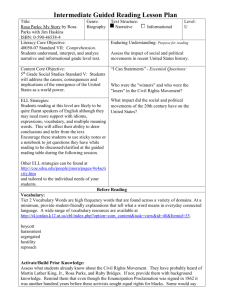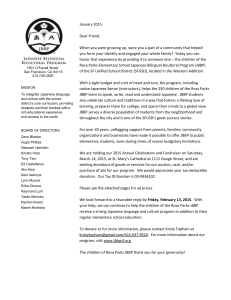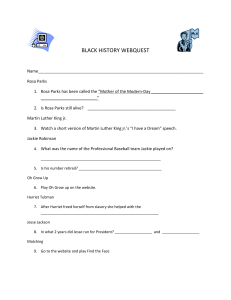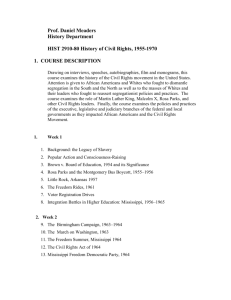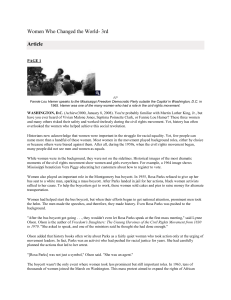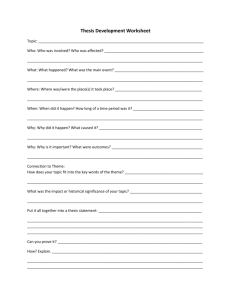Directed Reading Activity (DRA)
advertisement
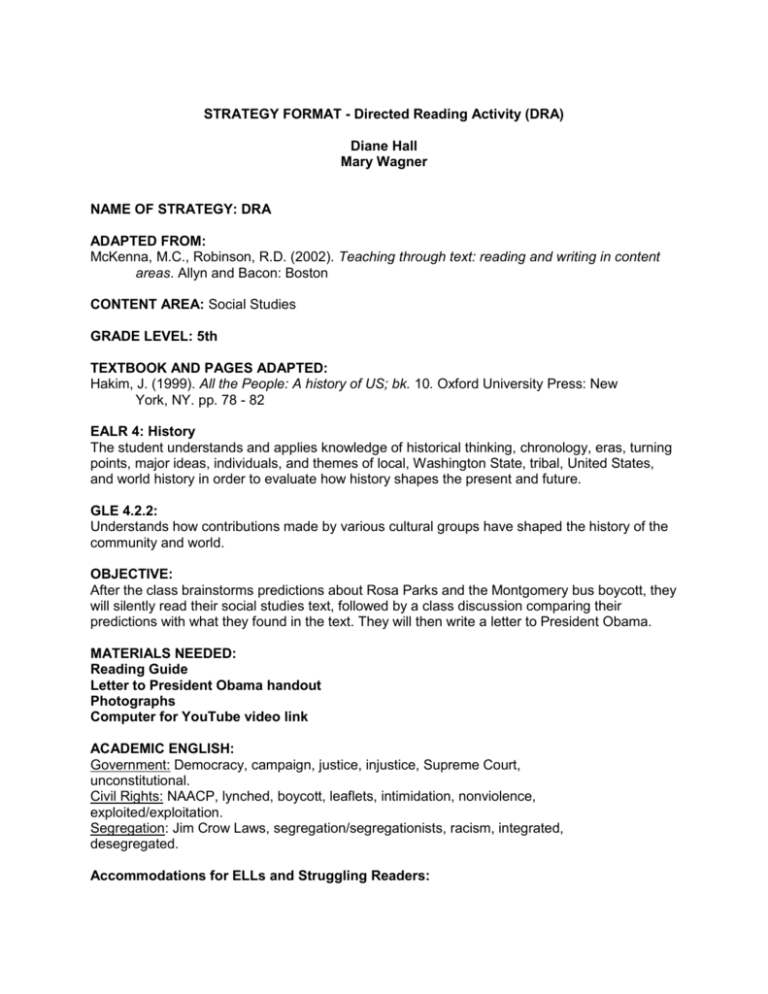
STRATEGY FORMAT - Directed Reading Activity (DRA) Diane Hall Mary Wagner NAME OF STRATEGY: DRA ADAPTED FROM: McKenna, M.C., Robinson, R.D. (2002). Teaching through text: reading and writing in content areas. Allyn and Bacon: Boston CONTENT AREA: Social Studies GRADE LEVEL: 5th TEXTBOOK AND PAGES ADAPTED: Hakim, J. (1999). All the People: A history of US; bk. 10. Oxford University Press: New York, NY. pp. 78 - 82 EALR 4: History The student understands and applies knowledge of historical thinking, chronology, eras, turning points, major ideas, individuals, and themes of local, Washington State, tribal, United States, and world history in order to evaluate how history shapes the present and future. GLE 4.2.2: Understands how contributions made by various cultural groups have shaped the history of the community and world. OBJECTIVE: After the class brainstorms predictions about Rosa Parks and the Montgomery bus boycott, they will silently read their social studies text, followed by a class discussion comparing their predictions with what they found in the text. They will then write a letter to President Obama. MATERIALS NEEDED: Reading Guide Letter to President Obama handout Photographs Computer for YouTube video link ACADEMIC ENGLISH: Government: Democracy, campaign, justice, injustice, Supreme Court, unconstitutional. Civil Rights: NAACP, lynched, boycott, leaflets, intimidation, nonviolence, exploited/exploitation. Segregation: Jim Crow Laws, segregation/segregationists, racism, integrated, desegregated. Accommodations for ELLs and Struggling Readers: ● ● ● ● ● ● ● ● ● Background knowledge was built through watching Eyes on the Prize, and reading the picture book Martin’s Big Words. Learning objective written on the board is kid friendly; read, spoken, and paraphrased by students. Using images of the bus boycott and Rosa Parks to build background and provide an affective entry point to the discussion. Explicit teaching of text structure (photo captions). Students work in pairs to fill out reading guide. (ELLs and Struggling Readers are paired with more capable peers). The purpose for reading is determined by students. During silent reading time, the teacher reads the text aloud to a group of struggling readers, highlighting academic English vocabulary. Video of President Obama provides an additional lesson entry point for ELLs. Class discussion allows ELLs to hear how ideas are expressed by peers. PROCEDURES: Last week the class watched an excerpt from the documentary series Eyes on the Prize which focused on the Martin Luther King and the Montgomery bus boycott (this helped build background for students). The students also read and discussed the informational picture book Martin’s Big Words. Students were introduced to the Civil Rights era and vocabulary such as: segregation, racism, justice, injustice, boycott, non-violence, and campaign. Today students will be completing a guided reading of the textbook and continuing to discuss and deepen their understanding of the Civil Rights movement and how it has shaped recent history of the United States, specifically related to the election of our first African American president. Teacher calls on a student to read the objective. KF Objective: ● Today we will brainstorm predictions about Rosa Parks and the Montgomery bus boycott. ● We will read our social studies book to see if we made the right prediction. ● We will talk about our predictions as a whole class. ● We will each write a letter to President Obama. Agenda: One hour lesson (approximately) Review of civil rights movement -- 5 minutes Brainstorming about Rosa Parks -- 10 minutes Silent reading (Read aloud - ELLs) -- 10 minutes Class discussion -- 15 minutes Watch video -- 5 minutes Write a letter -- 10 minutes Step 1. Assist students in developing purposes for reading a. Determine Students background related to the material to be read. Students will respond to an image of the bus boycott projected on screen (Pictures below), followed by a brainstorming session where students make predictions about Rosa Parks and the civil rights movement. The teacher will ask questions to elicit student thinking, feelings and will remind students about how they might use vocabulary words. Teacher: Look at these two pictures. What do these images make you think about? How do they make you feel? Do any of the vocabulary words we have been learning go with these pictures? Teacher: Now that we’ve thought about these pictures, we are going to make some predictions about what we are going to be reading today. We will be reading a chapter in our social studies textbook about Rosa Parks. (Teacher points to the image of Rosa Parks). This is Rosa Parks. There is a whole chapter in our textbook about her. What do you think the chapter will tell us about her? Does anyone have a prediction about what we will learn about her? Who is she? What did she do? What might a day in her life look like? (Ask students to critique each others ideas in an effort to get a variety of possibilities on the board) Why might she be important? How might her actions have changed the course of history? How is the country different today because of Rosa Parks? b. Provide appropriate teaching - address lack of information or misconceptions Teacher: Before we start reading, I want everyone to turn to page 80. We are going to look at picture captions. Looking at the page we can see that there are a different texts printed on the page. How can we determine, or figure out, which words are used for different purposes? (Project the page on the overhead) Talk with your elbow buddies for one minute about how many different uses for text you see on page 80 and what you think think they are being used for. Do a quick think/pair/share - Highlight the three different uses for text on the page. Confirm that ELL and struggling readers understand - ask them to repeat the information shared in their own words. c. Discuss vocabulary introduced in the material to be read. Write the vocabulary on the board. Teacher: Looking at the pictures, what do you think of these words? Each word has a number by it that coincides with your table groups. For example, the word respect has a 1 so it belongs to table group 1. Protest has a number 7, so it belongs to table 7. For the next 3 minutes I want each table group to talk about their word and write down 3 ideas of what they think it means in the context of civil rights. Afterwards each group will will share their ideas with the class. I may call on anyone in the group, so everyone needs to be able to provide an answer. Respect - 1 Unconstitutional - 2 Boycott - 3 Nonviolence - 4 Segregation - 5 Humiliate - 6 Protest - 7 Jim Crow Laws - 8 Step 2. Facilitate reasoning as students read. Teacher: Now we are going to read the text. You need to read all the text on every page, including the picture captions. I have a reading guide that will help you all test some of the predictions that you made during the brainstorm. As you read make sure to keep in mind how these events might have helped shape history. You will have about 10 minutes to read and work on the guide then we will come together for a discussion. Students read silently while completing a reading guide a. Guided reading. Teacher gathers a small reading circle of ELLs and struggling readers to read and fill out the guide together. After getting them going teacher circulates to answer questions b. Break down longer assignments into manageable segments. Students check their predictions after reading each section, recording answers on the reading guide. Reading Guide: Chapter 15: Rosa Parks was Tired Passage 1 (p.78) Put a check beside the statements that are true. 1.________Rosa Parks was a respected citizen in the community. 2.________In the 1950s, in Southern states, African American and Whites were treated equally. Write a short response to the following items. 3. Other than being tired, why didn’t Rosa Parks want to give up her seat on the bus? 4. Should Rosa Parks have given up her seat? Why or why not? 5. Briefly describe how passage 1 did or did not match yours or a classmate’s predictions. Passage 2 (p.78 - 79) Put a check beside the statements that are true. 1.________Rosa Parks was beaten and abused while in jail. 2.________Rosa Parks broke the segregation law. Write a short response to the following items: 3. Why was the bus driver filled with rage? 4. Should Rosa Parks have been sent to jail for what she did? Why or why not? 5. Briefly describe how passage 2 did or did not match yours or a classmate’s predictions. Passage 3 (p.79 - 80) Put a check beside the statements that are true. 1.________The African American leadership in Montgomery resisted segregation on city buses. 2.________The NAACP used Rosa Park’s case to fight segregation. Write a short response to the following items: 3. What did Montgomery’s black leaders think would happen when people stayed off the bus? 4. Imagine that you lived in Montgomery and you were asked to stay off the bus to protest segregation. You need to get to the store to buy food for dinner. The store is 2 miles away. Would you ride the bus? Why or why not? 5. Briefly describe how passage 3 did or did not match yours or a classmate’s predictions. The guides will go into your binders and will help you with the final project. Step 3. Help students test their predictions After students have read the selection, remind them of their predictions. The whole class will take part in a discussion about their predictions and the text. Teacher: Now that we’ve read the text, let’s return to the predictions that you made earlier and see how accurate they were. Class discussion: Referring to the predictions and your reading guides: ● Who can tell me how things are different today from how they were in Rosa Parks’s time? ● What are some of the problems that African Americans had to deal with? (Racism, injustice, segregation - what do these things look like? Give me examples). ● What ideas did they have about solving those problems? (Boycott, movement, protest what did these things look like, concrete examples) ● Which idea did they choose? (Non-violence, peaceful protest - Why did they choose this method of resistance?) ● Did it solve the problem? How is the country different today? What do you see or know that makes you think things have changed or that they have not changed? (I expect the students to make a connection between Rosa Parks and President Obama. If not, I’ll ask the students if people would have voted for an African American president back then. I will specifically ask students to think about how the civil rights movement helped shape the way our country is today so that students understand the word shape in the context of the writing prompt). Step 5: Extend students’ understanding of the material a. Use collateral materials where appropriate. Show a video clip of President Obama (then Senator Obama) speaking at Rosa Park’s funeral (5 minute clip) http://www.youtube.com/watch?v=pRsH92sJCr4 b. Stimulate student thinking through writing activities. At the end of the video put up a slide with the following two images to be left up while students respond to the following prompt. Post Assessment Teacher: (Passing out handout) We are going to all write a letter to President Obama. Today we will work on getting our ideas down and writing a rough draft. Handout: Letter to President Obama In your letter, be sure to include the following ideas: ● What I’ve learned about how the civil rights movement has helped shape the way the United States is today. (Rosa Parks, Martin Luther King). ● Why learning about the civil rights movement is important. ● One question I still have about the civil rights movement. ASSESSMENT RUBRIC Beginning Approaching Meeting Exceeding Reading Guide A few of the questions are answered with little to no support from the text Most of the questions are answered but not supported by details from the text Most questions are answered with many details supported by the text All questions on the guide are answered with details supported by the text Exit slip draft of letter (A rough draft will usually earn a grade of Beginning or Approaching) Draft does not include the three required elements. Draft includes some of the required elements. OR One element is well developed. Draft includes all three elements, at least two of which are fully developed Draft includes all three elements and each element was fully developed No elements are well developed.

